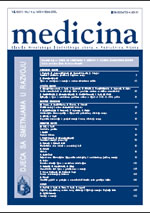
|
Medicina
Croatian Medical Association - Rijeka branch
ISSN: 0025-7729
Vol. 43, No. 2, 2007, pp. 107-112
|
 Bioline Code: me07014
Bioline Code: me07014
Full paper language: Croatian
Document type: Review Article
Document available free of charge
|
|
|
Medicina, Vol. 43, No. 2, 2007, pp. 107-112
| en |
Biological Properties Of Hepatitis C Virus
Hrstić, Irena & Vucelić, Boris
Abstract
The mechanisms of hepatitis C virus infection (HCV) and replication in targeted cells, the mechanism of persistent viral infection and the pathogenesis of HCV hepatic disease are poorly understood. HCV is a smallenveloped virus containing a positive-sense, singlestrained (RNA). It is classified in the separate genus Hepacivirus in the Flaviviridae family. HCV genome contains approximately 9600 nucleotides that encode a polyprotein of around 3000 amino acids depending on the genotype. The various genotypes are distributed into 6 main types (1-6) with various subtypes (a-c). Within its hosts HCV exists as a pool of genetically distinct but closely related variants called quasispecies. Hepatocytes appear to be the major site of HCV replication, but peripheral blood mononuclear cells and lymph nodes are also natural target cells. Because of the lack of convenient in vitro tissue culture systems for efficient virus propagation the current understanding of the molecular mechanisms of HCV replication is mainly hypothetic.
Keywords
hepatitis C virus; genome; heterogeneity; genotype; quasispecies; kinetics
|
| |
| hr |
Biološke Osobitosti Hepatitis C Virusa
Hrstić, Irena & Vucelić, Boris
Mehanizam infekcije, umnažanje virusa u ciljnim stanicama, tvrdokornost infekcije, te posljedično patogeneza kronične jetrene bolesti, nedovoljno su poznati. Hepatitis C virus (HCV) tvori malena jednolančana pozitivna RNA koja se svrstava u rod Hepacivirus u porodici Flaviviridae.
Genom virusa sadrži 9600 nukleotida koji – u ovisnosti o genotipu – sintetiziraju poliprotein od
približno 3000 aminokiselina. Razlikuje se 6 glavnih HCV genotipova (1 – 6), te više podtipova (a – c). Tijekom godina infekcije, virus u domaćinu postoji u obliku genetski različitih čestica nazvanih kvazivrstama. Virus hepatitisa C jest hepatotropni virus, stoga se glavnina njegova umnažanja zbiva u hepatocitu. No, u manjim količinama može se naći i u mononuklearnim
stanicama periferne krvi, te u limfnim čvorovima, stoga su i to prirodne ciljne stanice virusa. Poznavanje životnoga ciklusa virusa uglavnom je hipotetsko, s obzirom na nedostupnost učinkovite kulture stanica za istraživanja in vitro.
hepatitis C virus; genom; heterogenost; genotip; kvazispecijes; kinetika
|
| |
© © 2007 - Croatian Medical Association - Rijeka branch
Alternative site location: http://hrcak.srce.hr/medicina
|
|
